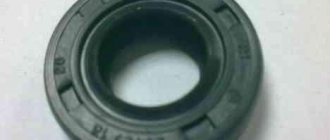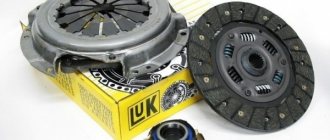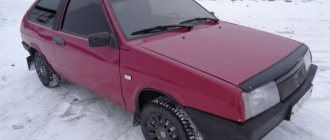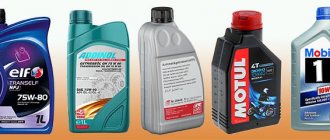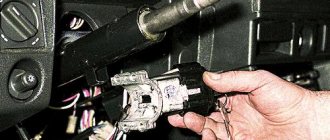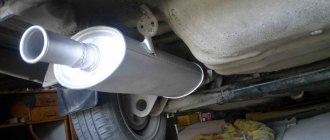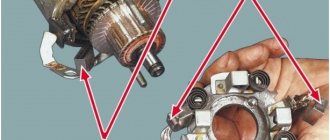The VAZ 2109 5-speed manual transmission was produced at a plant in Tolyatti from 1987 to 2005 and was installed on all numerous AvtoVAZ front-wheel drive models on the 2108-09 platform. This transmission is designed for torque of power units up to 1.6 liters and 120 Nm. The ninth family also includes 5-speed manual transmissions: 2113, 2114 and 2115. The main thing you need is to constantly monitor its condition, control work processes and not subject it to strong stress. The VAZ 2109 gearbox is reliable, as well as low maintenance costs, since Russian parts are much more affordable than foreign ones.
Gearbox housing
The gearbox housing is connected by pins to the clutch housing 29 during gearbox assembly and they together form a single unit. On the other hand, a rear cover 17 is attached to the gearbox housing, into which a breather 19 is pressed, connecting the crankcase cavity to the atmosphere. This prevents pressure build-up in the crankcase and oil leakage through the seals. The crankcase contains seats for the bearings of the primary and secondary shafts, as well as for the gearshift rod clamps. The clamps are closed with a common cover 8 (see Fig. 62), and the reverse lock is closed with plug 12. To fill the gearbox with oil, there is a hole closed with plug 2 (see Figure 59), and for draining the oil there is a hole closed with plug 3. The oil level should reach the bottom edge of the filler hole.
Useful tips
It is extremely important to monitor the serviceability of the gearbox, and if signs of breakdown are detected, fix them immediately. Do it yourself or with the help of a car service - this is your personal decision.
When operating a car in city conditions, you have to change gears more often. Therefore, it is recommended to use motor oil here. This ensures that the synchronizers remain effective longer. Transmission oil is better suited for highways, increasing the life of bearings and gears, although the synchronizer lasts less.
Internal structure of the box
Primary shaft
The input shaft 23 rotates in two bearings. The cylindrical roller bearing 26 is installed in the clutch housing socket, and the ball bearing is installed in the gearbox housing socket. The front end of the shaft at the exit from the crankcase is sealed with an oil seal, which is closed by the flange of the guide sleeve of the clutch release bearing. This flange is attached to the clutch housing with three bolts. The sleeve contains the clutch release bearing 31. The rear bearing 18 is fixed on the shaft with a nut and is held against axial displacement in the crankcase socket by an adjusting ring, which is pressed by the cover 17 to the gearbox housing. The nut is fixed by caulking its collar into the groove of the shaft.
The input shaft is made in the form of a block of drive gears of 1st, 2nd, 3rd, 4th gears and reverse. The clutch driven disc is located at the splined end of the shaft.
Malfunctions and their elimination
Gearbox repair largely depends on the nature and type of fault. There are several options for the breakdown of this unit, in each of which appropriate actions should be taken to eliminate them.
| Malfunction | Possible reasons | What do we have to do |
| There is noise in the gearbox |
|
|
| Gears are difficult to shift |
|
|
| Spontaneous gear disengagement occurs |
|
|
| Gears are switched on with noise and crackling |
|
|
| There is an oil leak from the gearbox |
|
|
In most cases, problems with the gearbox are eliminated by dismantling and disassembling it. Do not take on this type of work without the proper skills and experience.
Secondary shaft
The secondary shaft 33 is manufactured integrally with the main gear drive gear. The front end of the shaft rests on a cylindrical roller bearing 32, and the rear end on a ball bearing 16. The front bearing is located in the clutch housing socket, into which a rubber plug is pressed for sealing. The rear bearing is secured to the shaft with a nut, which is fixed in the same way as on the input shaft. The secondary shaft is held together with the rear bearing from axial displacement by its mounting ring.
Driven gears of 1st, 2nd, 3rd and 4th gears and two synchronizers are installed on the secondary shaft on needle bearings with plastic cages. Bracelet-type needle bearings, which facilitates the installation of gears on the shaft. Installing gears on needle bearings reduces friction losses and increases gearbox efficiency. Gear 6 of the first gear is clamped between the thrust washer and the locking ring of the synchronizer hub of 1st, 2nd gears and reverse gear, gear 8 of the second gear is sandwiched between the second locking ring of the same synchronizer hub and the thrust half-rings 10 of the secondary shaft. The half rings are fixed on the shaft with a ball and a retaining ring 9, placed on the half rings. The gears of the 3rd and 4th gears are installed on the shaft in the same way. Only the needle bearing of gear 13 of the fourth gear is put on the bushing and a spacer ring is located between the bearing and the foot, and a thrust washer 15 is located between the bushing and the ball bearing.
What to pay attention to
So, following the instructions, we disassemble the gearbox of your VAZ 2109. Along the way, pay attention to the following points:
- Bearings. When they wear out, a noise from the box occurs. Plus, worn bearings negatively affect the condition of other gearbox elements;
- Synchronizers and sealing washers. If their condition leaves much to be desired, then the gears shifted poorly precisely because of them. Replace them;
- Clutch system, cotters, coupling hub clamps. All this must be replaced separately if there are signs of wear or defects;
- Blocking rings, synchronizers. If there are chips or nicks, don’t even think about alternative solutions, replace them immediately;
- Bearing tracks. Over time they wear out. If signs of wear are found, perform a complete replacement. In this state, they were only a short time away from breaking;
- Gap between gears and locking rings. Normally it is no less than 0.6 mm. In case of deviations, there is only one solution - replacing the rings;
- Retaining rings. If elasticity is lost, these elements must be changed, since they will no longer be able to perform their functions.
When assembling the gearbox, do not forget to lubricate the new gaskets with a layer of lithol. And when pressing the oil seals, do it with the working edge inward. The metal clip should be located on the outside.
During the process of reassembling the gearbox, all rubbing components should be treated with oil, and do not forget about the sealant for connecting the clutch housings and gearbox. Doing everything yourself is quite possible.
Didn't find the information you are looking for? on our forum.
Synchronizer
The synchronizer consists of a hub 5 (Fig. 60), rigidly connected to the secondary shaft using splines, a sliding coupling 2, two locking rings 1, three cotters 4 with clamps 3 and springs, as well as synchronizer gears. The sliding clutch 7 (see Fig. 59) of the 1st to 2nd gear synchronizer has an outer ring for engaging reverse gear.
Rice. 60. Synchronizer parts:
1 — blocking ring; 2 — synchronizer sliding clutch; 3 — locking ball; 4 — retainer block; 5 — synchronizer clutch hub.
The synchronizer hub for 1st and 2nd gears is mounted on the splines of the secondary shaft and is secured on the shaft against axial displacement by two locking rings. The hub has six longitudinal grooves, three of which have slots for retainer springs. Rusks 4 (see Fig. 60) with retaining balls are installed in the same grooves. Springs press the clamps against the annular grooves of the coupling. On both sides of the hub there are bronze locking rings I with toothed rims, the pitch of which is equal to the pitch of the internal teeth of the sliding clutch and the gear rims of the gears of 1st and 2nd gears. The locking rings have six protrusions that fit into the grooves of the hub, with three short protrusions going into the grooves in which the clamps are located, and longer and wider ones into other grooves. These projections are installed in grooves with a lateral clearance equal to half the thickness of the coupling (hub) tooth, and limit the angle of rotation of the blocking ring relative to the hub. Thus, the hub rotates together with the blocking rings. With their conical surface, the blocking rings come into contact with the bevel belts of the 1st or 2nd gear gear at the moment the gear is engaged. To break the oil film at the point of contact and increase friction forces, especially fine threads and longitudinal grooves are cut on the conical surface of the ring.
The sliding clutch with its inner rim is seated on the outer gear rim of the hub and can move along the hub. To do this, the gear shift fork fits into the annular groove of the coupling. The ends of the coupling teeth are beveled at the same angle as the teeth of the blocking rings and synchronizer rims.
Backstage
If the gearbox on a VAZ-2109 is ringing, don’t be upset. All owners of "nines" have this problem. Moreover, the rocker rings both on “killed” and on relatively fresh cars. The AvtoVAZ representative office itself is aware of this defect. And vibration occurs due to the incorrect location of the support points of the internal combustion engine and the gearbox. As a result, the nodes vibrate, and the ringing is transmitted to all other parts, including the slide. Some solve this problem by installing an o-ring in the rocker area, others get used to it and drive like that, with a ringing sound.
idler gear
Intermediate gear 5 (Fig. 61) for reverse gear is straight-cut. A bushing is pressed into its hole, through which axle 4 passes. It is installed in the holes of the clutch and gearbox housings. The reverse gear fork 6 fits into the groove of the gear.
Rice. 61. Reverse intermediate gear:
1 — gear selection current; 2 — gear selection rod lever; 3 — three-arm gear selection lever; 4 — axis of the reverse intermediate gear; 5 — reverse intermediate gear; 6 — reverse fork; 7 — reverse light switch; 8 — reverse fork clamp.
Technical characteristics of the VAZ 2109 gearbox
| Type | Mechanics |
| Number of gears | 5 |
| For drive | front |
| Engine capacity | up to 1.6 liters |
| Torque | up to 120 Nm |
| What kind of oil to pour | TNK Trans KP 80W-85 |
| Lubricant volume | 3.4 liters |
| Change of oil | once every 75,000 km |
| Replacing the filter | every 75,000 km |
| Approximate resource | 150,000 km |
Differential
The differential is two-satellite. Its box 36 (see Fig. 59) rotates in two tapered bearings 35, the preload in which is adjusted by selecting the thickness of the ring 4. The driven gear 34 of the main gear is attached to the flange of the differential box, and the plastic gear 40 of the speedometer drive 42 is pressed onto the differential box. Gear 34 is in constant mesh with the drive gear of the main gear of the secondary shaft.
The satellites 37 and the semi-axial gears 39 have spherical bearing surfaces. The use of a solid sphere in the differential box, coupled with gears and satellites, made it possible to eliminate the support washers of the semi-axial gears.
The satellites are located on an axle 43, which is held in the holes of the differential box by retaining rings 44. The landing journals of the axle have grooves to retain lubricant. The holes of the semi-axial gears have internal splines into which the splined shanks of the housings of the internal hinges of the front wheel drives fit.
About the oil
For good performance of the VAZ 2109, all important components must be coated with oil. Typically, the manufacturer independently determines the brand of engine and transmission parts that are recommended for use in cars of a given model.
If you do not have such information, you should consider the main purpose of the machine:
- if the VAZ is driven on excellent roads in the regional center, there is a certain type of oil for this;
- if you drive a car, a transmission would be the ideal option.
Remember to maintain the optimal oil level
When filling oil, it should be taken into account that the VAZ 2109 box requires a slightly larger amount. Only this approach will help protect and cover all spare parts located at the crankcase outlet.
Since the gearbox is the second most important element of a car, in the event of the slightest breakdown it is necessary to immediately eliminate the shortcomings.
Let's look at the main malfunctions that can occur with the gearbox.
Automatic transmission shutdown
- worn gears and locks on the coupling;
- failure to comply with vehicle operating rules;
- incorrectly selected speed mode;
- incorrect shifting with a poorly adjusted clutch;
- unprofessional gearbox repair (ignoring clutch replacement);
- ignoring repairs in the presence of extraneous noise in the form of crunching.
If you contact a service station in a timely manner, the VAZ gearbox can somehow be saved. If the condition is too neglected, count on expensive repairs.
What do the noises in the 2109 box mean?
There are no silent boxes. Each of them has a maximum permissible noise level, which is established by GOST.
- Extraneous noise from the VAZ box may occur as a result of the operation of gears and bearings;
- Used or low-quality oil also causes noise;
- Sometimes the reason for its appearance may be the operation of the power unit. In this case, the speed may be unstable or a powerful camshaft may be installed.
It takes forever to describe extraneous noises, since each driver hears them differently. To more fully understand the cause, it is necessary to diagnose the transmission.
Crunching sound when changing gear
- Excessive or improper use of the vehicle.
If there is a crunching noise, the synchronizer will need to be replaced. If you decide to save money on it, you should expect to buy a whole block of gears in the future. In addition, the presence of a crunching sound may indicate that it is time to change the used oil. Or perhaps it was filled with the wrong degree of viscosity?
Knocks
- If you hear knocking noises in 21099, you should immediately check the gears. Perhaps one of the pairs has a chip;
- If a knocking noise occurs while driving, or when you switch the gearbox from one gear to another, pay attention to the satellites. Most likely they are the ones that have worn out.
The gearbox on a VAZ burst
- Whether or not to purchase a new box is up to you. Judge for yourself, repairing it can cost you the same price as buying a new one.
The box is unstable and switches hard
- The cause of this type of problem with box 21099 is the synchronizer or gear. In some cases, this situation may occur when purchasing new gearboxes or after repairing them.
In any case, you should know that when buying a new car you need to run it in. Rough operation of the vehicle leads to serious problems.
The lever is dangling
If the gearshift lever on a VAZ-2109 is loose, you should check the serviceability of the gearbox hinge (cardan). They have a tapered bolt that can unscrew. In most cases, the problem is solved by tightening it. Note that this bolt is tightly tightened from the factory. It is unscrewed to adjust the scenes.
Backlash also occurs due to a broken return spring, which is located in the gearbox mechanism. It usually changes every 4 years or 100 thousand kilometers.
The cone bolt also unscrews. It is smaller in size than the cardan and is located inside the box itself under the gear shift element.
Oil disappears
Unlike engine oil, rarely does anyone check the transmission oil level. But in vain, because sometimes you can simply get a dry dipstick. If measures are not taken in time, increased noise will appear (since the gears are running dry). For what reasons does oil leak from the box? There are several factors:
- The crankcase cover does not fit tightly.
- Worn shaft seals.
- Loose oil drain cap.
- Cracks in the transmission pan (solved by replacing the element).


